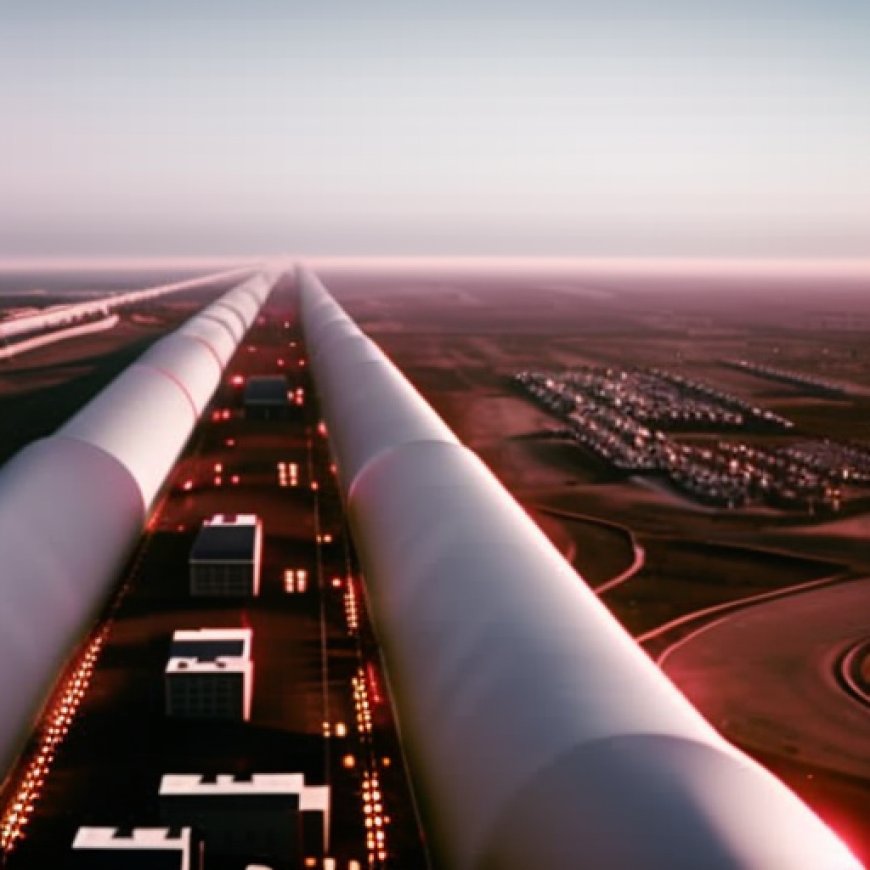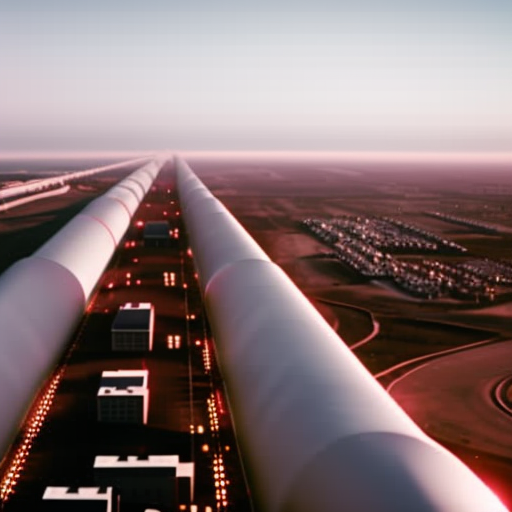As Russia Pummels Power Plants, Ukrainians Advance On Renewable Energy Front
As Russia Pummels Power Plants, Ukrainians Advance On Renewable Energy Front Radio Free Europe / Radio Liberty


ZHASHKIV, Ukraine
Vadym Kolisnyk and the Power of Solar Energy
Vadym Kolisnyk stands on a rooftop on the eastern edge of Zhashkiv. It’s the end of February, and the dark and fog that shroud central Ukraine for much of the winter have broken. The sun has returned to Cherkasy Oblast.
This is good news for Kolisnyk, for whom the sun is money. Solar panels stretch along aluminum frames that go all the way to the eastern face of the barn roof on which he stands. Beyond, fields of grain wait for sowing. The lowing of some 3,000 cows, mostly Holsteins, rises to the rooftop – along with the smell, inescapable now that the thaw has come.
Zhashkiv straddles the main highway between Uman and Bila Tserkva in Cherkasy Oblast, about 150 kilometers south of Kyiv. Kolisnyk lives in the city of Cherkasy, installing independent solar systems like this one from there to the Kyiv Oblast with his company, SolarGlass.
A year ago, Zhashkiv had virtually no solar power systems. But as Kolisnyk tells it, by virtue of knowing the right people, over the past year he’s become the go-to guy for solar within this town of 12,000.
Russia’s war against Ukraine has shifted his focus from big commercial plants to private homes and small businesses, but he has more orders than he can manage – in large part because six of his employees have gone to the front since the full-scale invasion of February 2022. Two remain there, while four “are no longer with us,” he says.
The Project in Zhashkiv
The team of installers working on the project in Zhashkiv, expected to take a few weeks to complete, stay in temporary farmhand quarters — seven unmade beds in a small room on the second floor of a brick building between the orchard and the grain fields. DVDs in the thin black cases that suggest unofficial provenance are stacked half a meter high on the floor next to a dresser on which sits a TV. A cabbage, dishwashing detergent, a bottle of cheap Georgian brandy, and stray packs of cigarettes line the windowsills.
One of the residents, Volodymyr, says he’s saving up because his daughter was in competitive motocross but has outgrown her current bike. He has his eye on a new one for when the competitions — on hold since the invasion — resume.
The Sustainable Development Goals (SDGs)
- No Poverty
- Affordable and Clean Energy
- Decent Work and Economic Growth
- Industry, Innovation, and Infrastructure
- Sustainable Cities and Communities
- Climate Action
- Partnerships for the Goals
The Impact of Russia’s Attacks on Ukraine’s Electrical System
Power Lifting
Russia has attacked Ukraine’s electrical system continuously since the full-scale invasion began. After seizing several of the country’s biggest power plants in the initial push, Moscow’s forces have repeatedly targeted the Ukrainian grid with missiles and drones. This has forced Ukrainians to cut consumption, fortify production, and seek alternatives.
“I believe that there is no alternative to a green transformation of the economy, and Russian aggression has proved that a green transformation is one of the key foundations of security,” President Volodymyr Zelenskiy told a conference in London last June.
More recently, Russia has concentrated fire on the great tangle of transmission infrastructure in east-central Ukraine’s Dnipropetrovsk and Zaporizhzhya regions.
On the morning of March 22, Russia launched a wave of air strikes across the country, hitting key facilities including the Dnipro Hydroelectric Station in Zaporizhzhya and causing blackouts at several locations in what Energy Minister Herman Halushchenko called “the largest attack on the Ukrainian energy industry in recent times.”
The Transition to Renewable Energy
A Transition Deferred
Ukraine formally renounced Russian gas imports in 2015 and sanctioned Russia’s big oil companies in 2018. Though a conspicuous indirect trade in fuels of “unknown origin” remained open until last May, between 2018 and 2021, Ukraine’s total installed solar and wind generation capacity quadrupled and tripled, respectively.
The two combined accounted for only 10 percent of Ukraine’s total generation in 2021, the last year for which official data is available, but they were the fastest-growing new generation source by miles — or megawatts.
Ukraine still had to rely on Russia for the lion’s share of the uranium for its nuclear plants — still the largest source of electricity in the country. Due to continued connection to the Soviet-era grid, Ukraine also had no choice but to buy electricity from Russia and Belarus in times of shortage — and sell it in times of surplus — right up until February 24, 2022.
Missed Connections
As with so many sectors of Ukraine’s innovation economy, the Russian invasion completely derailed the rapid growth in renewable energy.
The biggest wind and solar plants were in the east or along the southern corridor from Mariupol up to Kherson — the sunniest part of the country, which also happens to get gusts off the Black Sea, and most of which Russia has held since early in the invasion.
Even on the Ukrainian-controlled side of the line, there are visible signs of a transition stalled.
In fields alongside Oshakiv, a town in the Mykolayiv Oblast west of Kherson, concrete slabs roughly the size and shape of ridged mattresses have stood in stacks like something from an industrial version of The Princess and the Pea, derelict for over two years.
The location, just a few hundred crop rows from the Black Sea, was one its builders fought for, gathering locals to persuade them that the wind farm would bring them more money without ruining their town. Then came the war.
“As it turned out, this land was under fire every day,” says Oleksandr Burdun, who was overseeing the construction of that wind plant.
The Extent of the Damage
Power Stats
The damage is extensive.
SDGs, Targets, and Indicators
SDGs Addressed:
- SDG 7: Affordable and Clean Energy
- SDG 9: Industry, Innovation, and Infrastructure
- SDG 11: Sustainable Cities and Communities
- SDG 13: Climate Action
Targets Identified:
- Target 7.2: Increase substantially the share of renewable energy in the global energy mix
- Target 9.1: Develop quality, reliable, sustainable, and resilient infrastructure
- Target 11.6: Reduce the adverse per capita environmental impact of cities
- Target 13.2: Integrate climate change measures into national policies, strategies, and planning
Indicators:
- Indicator for Target 7.2: Proportion of renewable energy in the total final energy consumption
- Indicator for Target 9.1: Proportion of the rural population who live within 2 kilometers of an all-season road
- Indicator for Target 11.6: Annual mean levels of fine particulate matter (e.g., PM2.5) in cities
- Indicator for Target 13.2: Number of countries that have integrated climate change measures into national policies, strategies, and planning
Analysis:
1. Which SDGs are addressed or connected to the issues highlighted in the article?
The issues highlighted in the article are connected to the following SDGs:
- SDG 7: Affordable and Clean Energy – The article discusses the importance of renewable energy, such as solar power, in ensuring a secure supply of electricity in Ukraine.
- SDG 9: Industry, Innovation, and Infrastructure – The article highlights the role of builders and renewable energy providers in the fight to keep the lights on in Ukraine and the need for resilient infrastructure.
- SDG 11: Sustainable Cities and Communities – The article mentions the impact of the Russian invasion on renewable energy projects and the stalled transition to green electricity in Ukraine.
- SDG 13: Climate Action – The article emphasizes the importance of a green transformation of the economy and integrating climate change measures into national policies.
2. What specific targets under those SDGs can be identified based on the article’s content?
Based on the article’s content, the following targets can be identified:
- Target 7.2: Increase substantially the share of renewable energy in the global energy mix – The article discusses the growth of solar panel installations and the importance of renewable energy sources like solar power in Ukraine’s energy independence.
- Target 9.1: Develop quality, reliable, sustainable, and resilient infrastructure – The article highlights the need for resilient infrastructure to withstand attacks on Ukraine’s energy system and the role of builders in ensuring a secure supply of electricity.
- Target 11.6: Reduce the adverse per capita environmental impact of cities – The article mentions the stalled transition to green electricity and the impact of the Russian invasion on renewable energy projects, indicating a need to reduce the environmental impact of cities.
- Target 13.2: Integrate climate change measures into national policies, strategies, and planning – The article emphasizes the importance of a green transformation of the economy and integrating climate change measures into national policies in response to the Russian aggression.
3. Are there any indicators mentioned or implied in the article that can be used to measure progress towards the identified targets?
Yes, there are indicators mentioned or implied in the article that can be used to measure progress towards the identified targets:
- Indicator for Target 7.2: Proportion of renewable energy in the total final energy consumption – The article discusses the growth of solar panel installations and the increasing share of renewable energy in Ukraine’s energy mix.
- Indicator for Target 9.1: Proportion of the rural population who live within 2 kilometers of an all-season road – The article mentions the installation of independent solar systems in private homes and small businesses, indicating improved access to reliable infrastructure.
- Indicator for Target 11.6: Annual mean levels of fine particulate matter (e.g., PM2.5) in cities – The article mentions the need to reduce the adverse environmental impact of cities, which can be measured by monitoring air quality indicators like PM2.5 levels.
- Indicator for Target 13.2: Number of countries that have integrated climate change measures into national policies, strategies, and planning – The article emphasizes the importance of integrating climate change measures into national policies in response to the Russian aggression, indicating progress towards this indicator.
Table: SDGs, Targets, and Indicators
| SDGs | Targets | Indicators |
|---|---|---|
| SDG 7: Affordable and Clean Energy | Target 7.2: Increase substantially the share of renewable energy in the global energy mix | Proportion of renewable energy in the total final energy consumption |
| SDG 9: Industry, Innovation, and Infrastructure | Target 9.1: Develop quality, reliable, sustainable, and resilient infrastructure | Proportion of the rural population who live within 2 kilometers of an all-season road |
| SDG 11: Sustainable Cities and Communities | Target 11.6: Reduce the adverse per capita environmental impact of cities | Annual mean levels of fine particulate matter (e.g., PM2.5) in cities |
| SDG 13: Climate Action | Target 13.2: Integrate climate change measures into national policies, strategies, and planning | Number of countries that have integrated climate change measures into national policies, strategies, and planning |
Behold! This splendid article springs forth from the wellspring of knowledge, shaped by a wondrous proprietary AI technology that delved into a vast ocean of data, illuminating the path towards the Sustainable Development Goals. Remember that all rights are reserved by SDG Investors LLC, empowering us to champion progress together.
Source: rferl.org

Join us, as fellow seekers of change, on a transformative journey at https://sdgtalks.ai/welcome, where you can become a member and actively contribute to shaping a brighter future.







